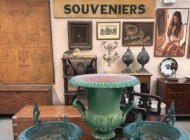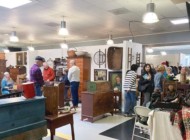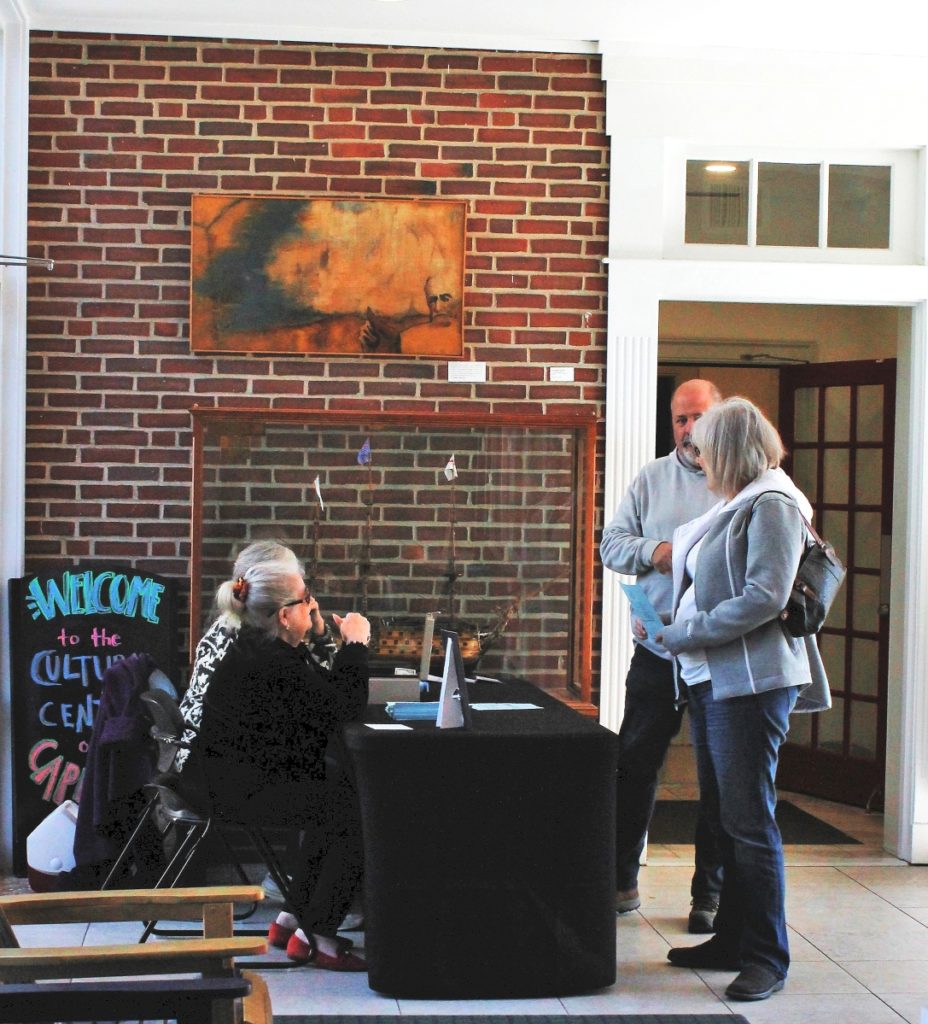
More than 50 customers had already arrived five minutes after the Cape Cod Glass Show’s 10 am opening.
Review & Photos by Z.G. Burnett
SOUTH YARMOUTH, MASS. – Fall had just arrived on September 24, with a chilly morning welcoming the Technicolor-blue skies that can only be seen on the Cape. The 34th Annual Cape Cod Glass Show & Sale set up for two days in the Cape Cod Cultural Center, safe from the pesky breeze. Hosted by the Cape Cod Glass Club (CCGC), the show is operated by a group of collectors, dealers, specialists and students of glass and its manufacture, its design and history. The club has been a chapter of the National American Glass Club (NAGC) since 2001, and its members meet monthly to present and discuss glass and glass-making, with guests that rank among the category’s top makers and experts.
The Cultural Center of Cape Cod was a perfect setting for the show, as it also has an interesting history within the community. The building formerly housed the Bass River Savings Bank, founded in 1874 when Yarmouth was still known as a quiet harbor village. Built in 1931, it was the bank’s first conventional establishment after being run in a piazza-style wooden building down the road. Bass River merged with another bank in 1982, which was then absorbed into Citizens Bank. The brick building was left empty until 2000, when Yarmouth citizens set out to rescue the historic structure. After six years and $700,000 in renovations, the Cultural Center opened and has since served more than 250,000 Barnstable County residents and visitors.
Betsy Hewlett Lessig, president of CCGC and co-manager of the show, gave Antiques and The Arts Weekly a warm welcome while setting up her own booth of early American pattern glass. Lessing and her husband, Jim, have been working with the CCGC for 10 years, and she also displays at The Mews at Brewster Antiques (Brewster, Mass.). Lessig later shared that many of the vendors had their best show in some time, and one new vendor had their best show ever. “This is the nicest show we’ve ever done,” Lessig said after the first day’s opening. It was an unsurprising result, as the rainbow of glass on display in the historic building was Oz-like in the multicolored and multifaceted offerings at every table.
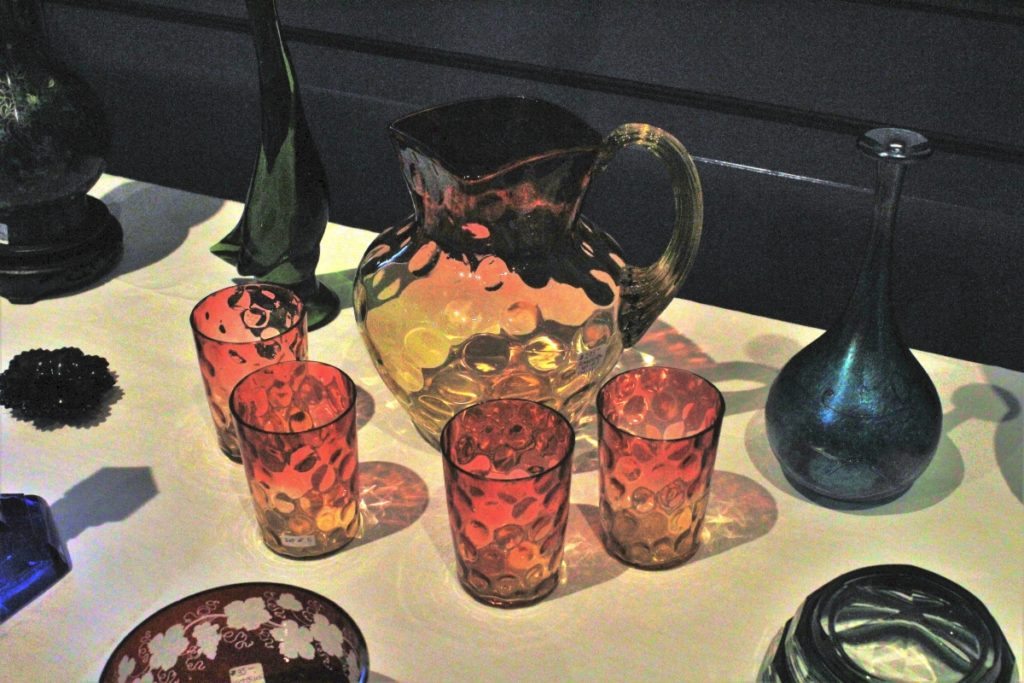
Colored like a sunset, this five-piece midcentury drinkware set from the New Bedford Glass Club was priced at $275.
The New Bedford Glass Club had a booth at the show, offering glass from all decades of the late Nineteenth and Twentieth Centuries. Many of these pieces had a nautical theme, including a Phoenix Consolidated glass seagull vase for $195. Formed in 1880, the Phoenix Glass Company began its business making oil and glass lamps, later moving on to light bulbs and shades when electricity was introduced. Phoenix is best known for its sculptured art glass, produced from 1933 to 1958. The distinctive appearance of these pieces is achieved with a jointed mold that followed the glass’s patterns to avoid lines in the finished product. Color was then applied to the ground of the raised designs, then fired onto the glass at over 1,000 degrees Fahrenheit. Placed alongside the vase was a deck prism for $25. These were installed in ships to refract sunlight into the lower holds and now are reproduced as attractive paperweights.
Education was a big component of the glass show, especially for the Stretch Glass Society (SGS) that shared a room with the New Bedford Glass Club. Bob Henkel and Billy Shrek represented SGS, with plentiful literature on their society’s mission, which is to encourage and support learning and interest in iridescent stretch glass, which was produced by nine American companies from 1912 to 1932. These produced over a thousand shape variations in a full spectrum of colors during their time in operation. The production of this type of glass dwindled down to just one company from the 1980s to 2011. None of the pieces on display were for sale. “We’re here to educate,” Henkel said. Their tables were decorated for Halloween, with the glass colors complemented by candy filling their many dishes. One “ribbon” dish with a pierced rim had just that woven through its slats, and both Henkel and Shrek were as cheery as their display.
Bruce Mitchell was at the show to sell, but also to identify objects that visitors brought to have inspected, and a desk across from his booth was stacked with books about glass for this purpose, reflecting the breadth of glass presented there. Like all members of the CCGC, Mitchell is a member of the NAGC, is on the board of the Museum of Connecticut Glass (Coventry, Conn.) and is secretary of the Southern Connecticut Antique Bottle & Glass Collectors Association. In his booth was everything from Venetian glass candlesticks to early American glass. There were few examples of the latter category at the show, which was mostly later art glass, and Mitchell’s examples were fine representatives. These included household names for glass collectors, such as a Sandwich, Mass., whale oil lamp with a free-blown saucer-base, globe front and a button stem, made of lead glass, circa 1825-28 for $675; and a Stoddard “umbrella” blown-molded amber ink, 1840-60; and a neck crack designated this price to $95. There were other examples from this era like an early brown Midwestern flask, circa 1800-30, sporting 24 swirled ribs around its body, for $300, and an adorable miniature aqua chestnut bottle from the first half of the Nineteenth Century for $165.
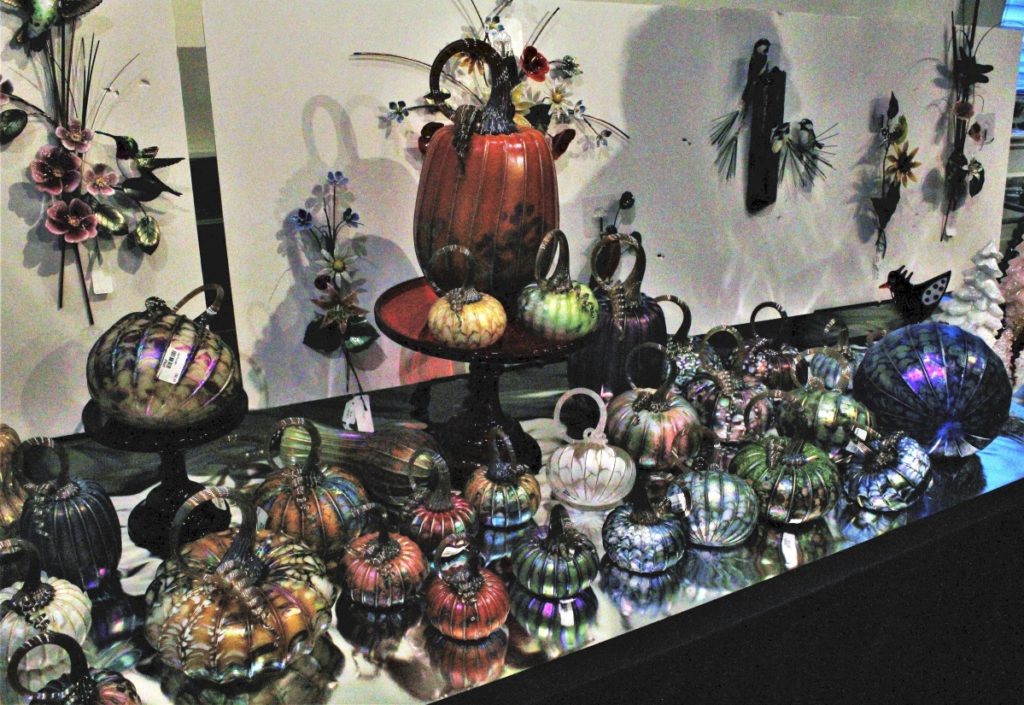
Jack Pine’s pumpkins are crafted by hand in his Laurelville, Ohio, studio, and are some of Glass Accents Etc.’s (Lilitz, Penn.) best-selling items.
One of the largest booths was occupied by Glass Accents Etc., a multidealer boutique in Lititz, Lancaster County, Penn., represented by LeeAnn Kornbau. The first pieces to catch our eye looked good enough to eat – a whole dish of glass petit fours locally-made by Hulet Glass from the coastal region of Northern California. These collectible treats have been created by self-taught sisters Dinah and Patty Hulet since the 1980s. There were more festive elements as well; a whole patch of iridescent stretched glass pumpkins from Jack Pine (Laurelville, Ohio), priced between $70 and $255, were arranged beside a forest of multicolored pine trees from Mosser Glass (Cambridge, Ohio), which were offered for $25 to $55 according to size. Pine studied at the Columbus College of Art and Design and worked in Seattle studios before returning to his roots in Southern Ohio. We were told that his pumpkins are highly sought-after and that they sell out quickly on his own website, so any buyer to pick one at the show that day was lucky indeed. Mosser Glass is a family-run business, established to fill the gap left by the Cambridge Glass Company’s closing in 1954. Its founder, Tom Mosser, had worked with Cambridge as a teenager and kept the dream alive by manufacturing glassware in an abandoned chickencoop before forming Variety Glass in 1959, which then grew into Mosser Glass in 1971.
Rose Colored Glass of Ogunquit, Maine, had its own room in the cultural center filled with natural light that showed its wares to great advantage. Jay Rogers and Jim Beverage offered pressed, blown and cut glass objects of all types. Rogers and Beverage have been showing with the CCGC for seven or eight years, and this was their third, and favorite, venue so far. A delicate four-piece set of glass rummers made from dark teal glass were prominent in their display, and with good reason. The floriate prunts were pressed by hand onto their stems, indicating their age as early Nineteenth Century. This design is well known to admirers of Dutch still lifes, whose artists would have referred to them as roemers. The prunts ensured a safe grip on the stem, and although the name means “Roman type,” the form is a traditional wine glass form in Germanic countries.
Gone but not soon forgotten, memorabilia of Queen Elizabeth II has become more prevalent at antiques shows since the monarch’s passing, and the Cape Cod Glass Show was no exception. Henry T. Callan of Sandwich, Mass., proudly displayed an 11-inch goblet with a majestic “E” etched into the surface. “It must be crystal,” Callan said before he sounded the goblet, which gave out a high, clear ring. It was made to commemorate the queen’s coronation on June 2, 1953, and offered for $335. Among his many other wares was a blown glass top hat whimsy vase; although a reasonably common form, this example stood out because of its large size and color. Blown with an optic swirl, the glass was a candy-pink with a milk-white ruffled rim. The hat tipped at $395.
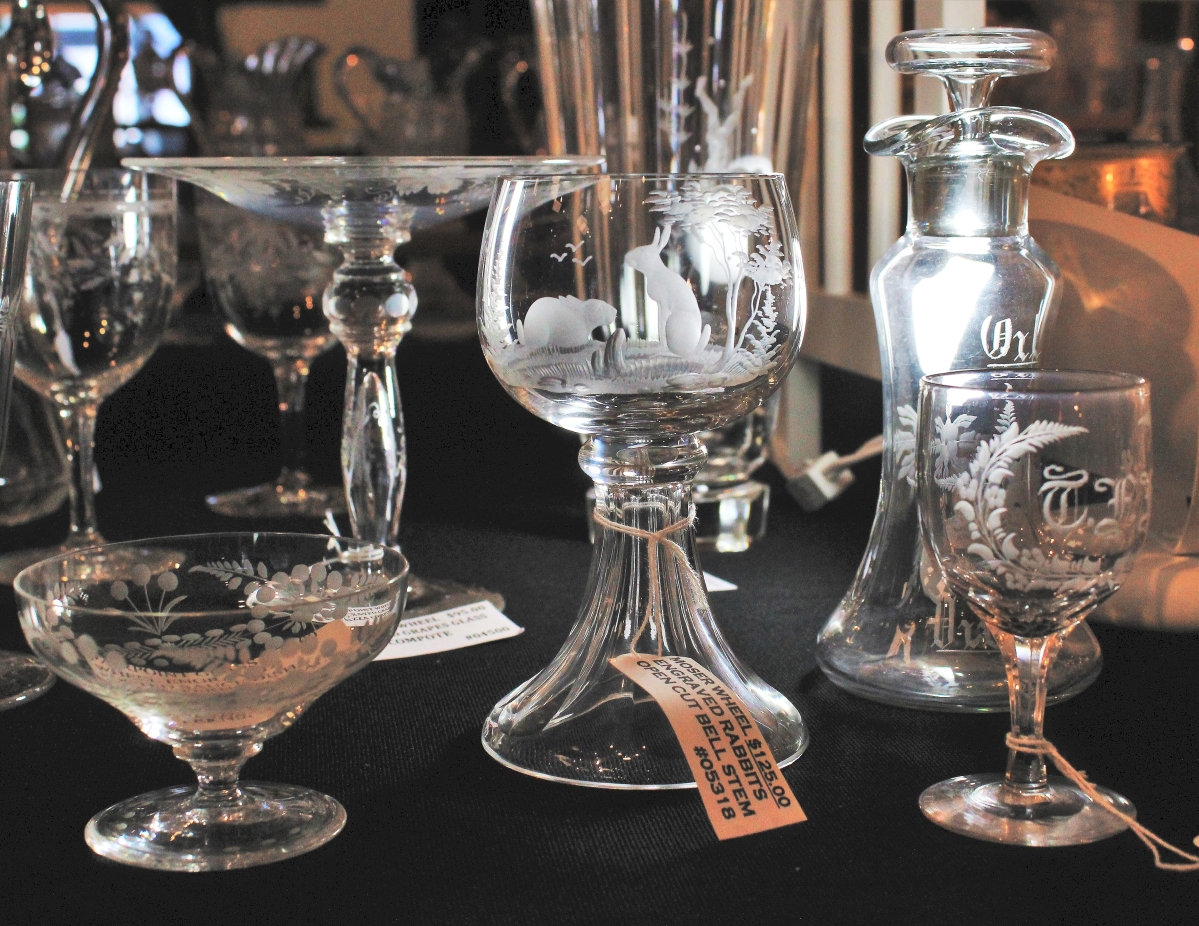
Diane Lytwyn was also offering a large collection of engraved glass, including this Moser Wheel wine glass with engraved rabbits for $125.
Next to Callan’s booth was Two J’s from Bolton, Conn., hosted by Jim Dwire. “I’m known for my colors,” Dwire said. The vibrant wares displayed was plain proof of that, with more than two thirds of Dwire’s stock being Fenton Art Glass. Made in Williamstown, W.Va., Fenton glass is highly collectible and can be found in almost every color on the spectrum. Founded in 1905, Fenton’s factory closed in 2011 after being run by third- and fourth-generation family members and is still sold out of Williamstown’s gift shop. Fenton glass is still produced with their original molds in an Ohio factory, however, this distinction only makes the earlier examples more desirable. Such were the Fenton pieces offered by Two J’s, including a rainbow of glass shoes that were priced from $14 to $55.
Pleasant Valley Antiques of Brookville, Md., occupied the cultural center’s vault, which was appropriate for the treasures they offered. Two pieces stood out for their refined reminiscences of times when excess was just beginning to be the height of elegance in commercial products. Couched in its original velvet case was a complete French condiment set, circa 1875. The vessels were meant to serve the traditional five French sauces, béchamel, velouté, espagnole, hollandaise and tomato. The blown glass containers were accompanied by dainty serving spoons, and the rare set was tagged $850. Behind it was an electric boudoir lamp with a hanging drop-prism shade, circa 1920, priced at $325.
Down the hall from the venue’s Great Hall was another function room full of vendors. Diane Lytwyn (Fairfield, Conn.) made an arresting display of ruby silvered mercury glass. This came as no surprise, as Lytwyn is author of the Pictorial Guide To Silvered Mercury Glass (2005), and was selling signed copies at her booth. According to Lytwyn’s website aptly named Antique Mercury Glass, mercury or silvered glass was made in Bohemia, England and United States from around the mid-Nineteenth Century to the first decades of the Twentieth Century. The effect was achieved by blowing the glass with double walls, then silvering between the layers with a solution containing silver nitrate and other materials. Lytwyn also sells glass and copies of her book on this website.
For information, www.capecodglassclub.org.

























